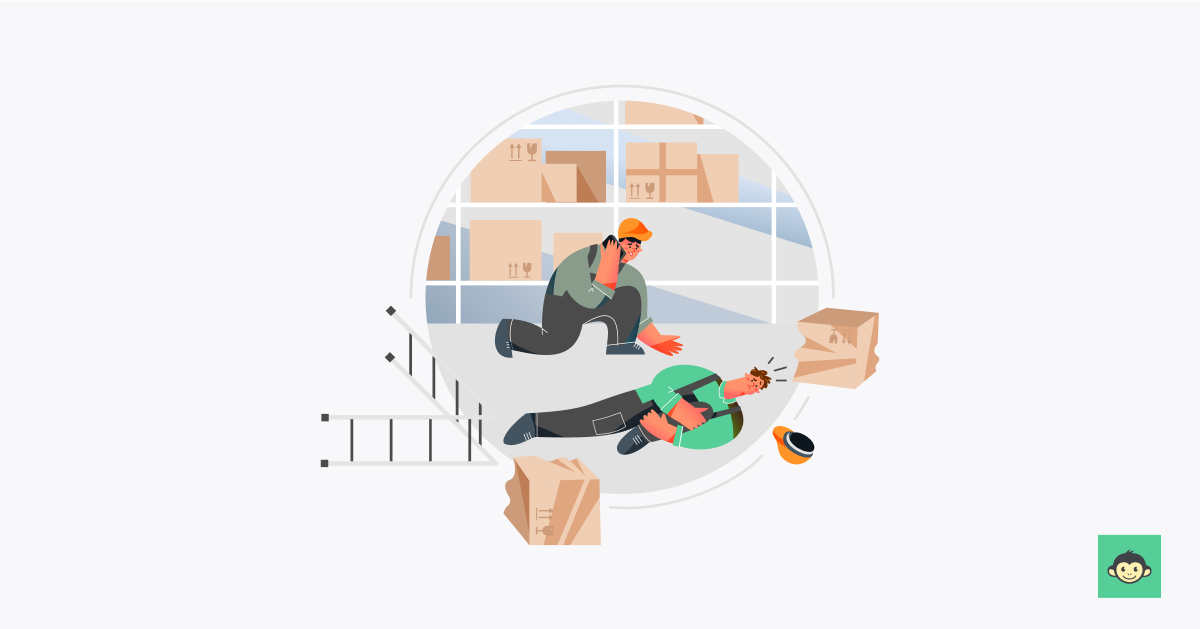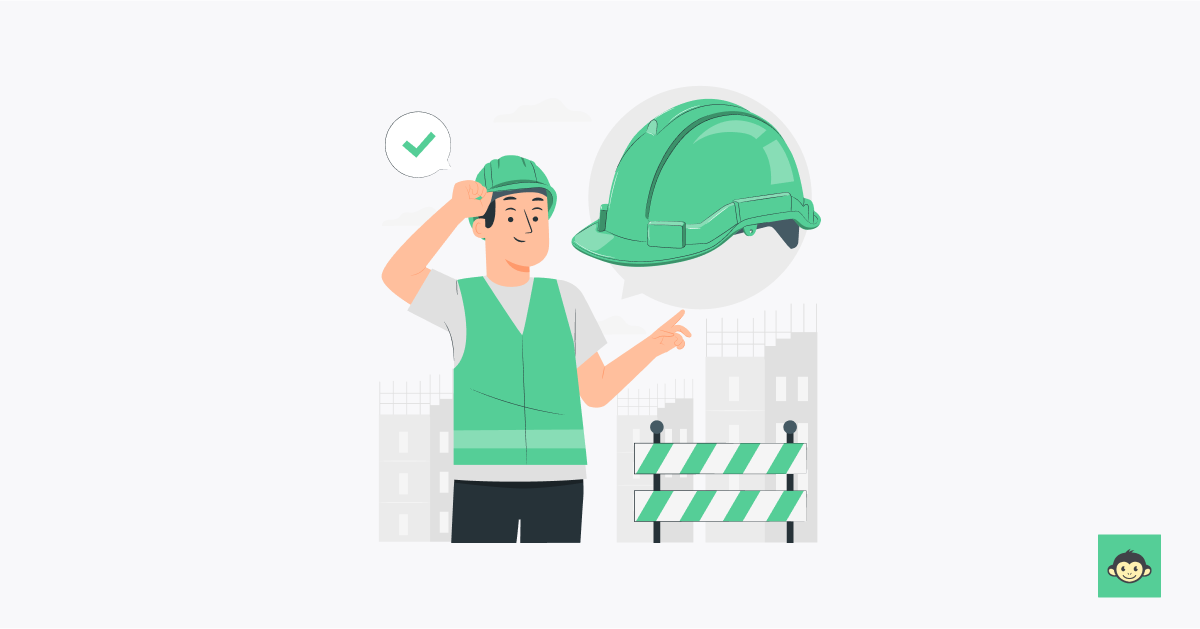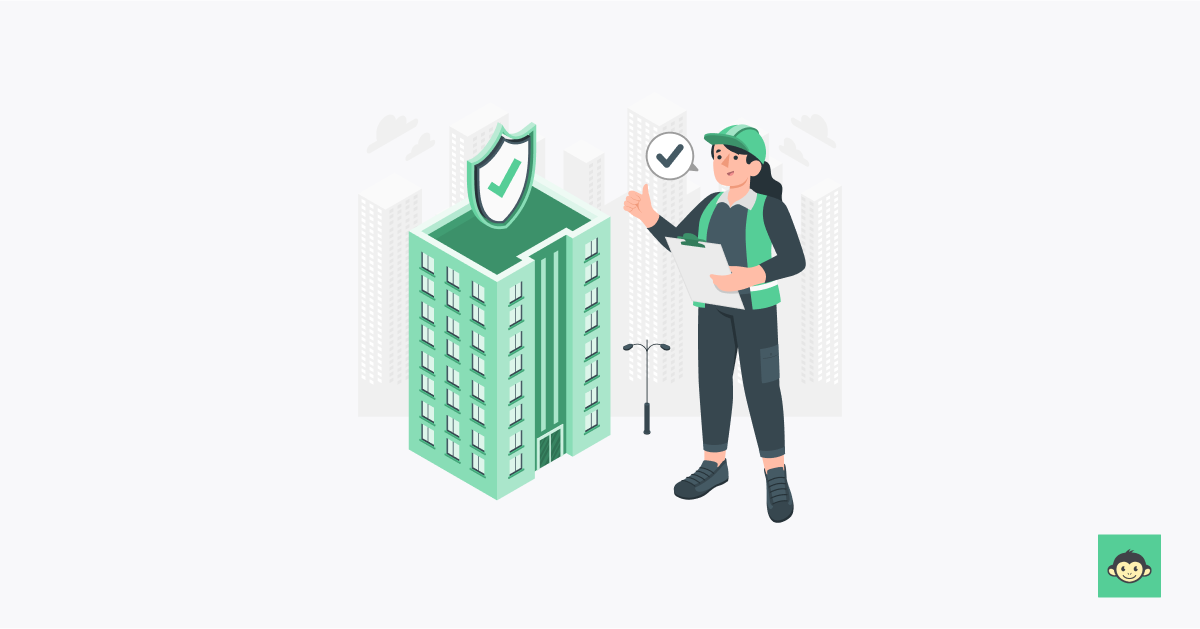Everything you need to know about workplace employee safety

Safety isn't just about avoiding the wrath of the office printer or mastering the art of avoiding small talk in the elevator. It's about creating a workspace where employees feel secure, motivated, and perhaps most importantly, where the coffee machine never runs out of beans.
As the legendary safety sage, Ansel Adams, once said, "Sometimes I arrive just when God's ready to have someone click the shutter." Now, I may not be God, and we're definitely not talking about photography here, but the sentiment rings true.
Safety is all about perfect timing—making sure you click the metaphorical shutter before chaos decides to strike a pose in your workplace.
So, whether you're a seasoned worker safety aficionado or a newbie in the world of hazard prevention, fasten your seatbelts, and let's navigate the labyrinth of workplace safety together.
What is employee safety?
Employee safety is the fortress that shields your workforce from the dragons of workplace hazards. It goes beyond the obligatory hard hat and fluorescent vest—it's a holistic commitment to the physical, mental, and emotional well-being of your team.
Picture this: it's not just about avoiding banana peels in the breakroom (though that's crucial, too!). It's a strategic dance between hazard identification, risk mitigation, and fostering a culture where safety isn't a chore but a shared responsibility.
From ergonomic desks that cradle your spine like a concerned grandma to digital tools that warn you before you turn the office printer into a modern art installation—employee safety is the art of anticipating, preventing, and responding to potential workplace stress and dangers.
It's the superhero cape that transforms your workspace into a risk-aware haven, ensuring everyone can focus on conquering deadlines without dodging metaphorical bullets. Because in the grand saga of work life, employee safety isn't just a chapter; it's the guiding plotline that ensures every hero in your office epic makes it to the final page unscathed.
Why is employee safety important?

The US Bureau of Labor Statistics reports that in 2021 there were 2.61 million workplace safety incidents which shows the importance of having risk mitigation measures in place.
Workplace safety is important because it safeguards the most critical asset—human capital. By systematically identifying and addressing potential hazards, organizations create a robust defense mechanism to train employees against injuries and occupational illnesses.
This not only preserves the workforce's physical and mental well-being but also mitigates the associated operational disruptions and financial liabilities.
From a productivity standpoint, employee health and safety is a linchpin. A healthy workforce is a productive workforce.
Ergonomically designed workstations, adherence to safety protocols, and proactive hazard management contribute to a seamless workflow, minimizing downtime due to health-related issues.
Now, let's talk about compliance. In the regulatory landscape, maintaining stringent, safety and health standards isn't just a legal obligation—it's a strategic imperative. Compliance ensures organizations avoid legal ramifications, hefty fines, and reputational damage, positioning them as responsible corporate citizens.
In the grand scheme of financial prudence, investing in employee and safety equipment, technologies and protocols is a preventive measure. It's the equivalent of an immunization shot against escalating healthcare and compensation costs associated with workplace accidents.
Benefits of safety in the workplace

Employee safety is not just a precautionary measure; it's an investment that pays dividends in productivity, financial stability, and a happy, thriving workforce. Let’s take the benefits it offers.
1. Enhanced productivity and efficiency
Imagine your workplace as a well-oiled machine, smoothly churning out tasks without the screech of unexpected disruptions.
A commitment to safety ensures that your team operates in an environment free from avoidable hazards, allowing them to focus on their tasks with undivided attention. This, my friend, is the recipe for peak productivity and operational efficiency.
2. Cost savings and risk mitigation
Safety isn't just a shield against accidents; it's a financial wizard's spell for cost savings. By identifying and mitigating potential risks to prevent workplace injuries, organizations dodge the financial bullets of compensation claims, medical expenses, and legal battles. It's the proactive strategy that prevents financial leaks and keeps the budget ship sailing smoothly.
3. Boosted employee morale and engagement
Happy employees are engaged employees, and nothing says "we care" like a commitment to safety. When team members feel secure in their workplace, morale skyrockets. Safety initiatives create a culture of trust and appreciation, fostering a sense of belonging.
In fact, the 2023 State of Employee Safety Report shows that mental health is the second most important priority at work, with 77% of employees saying it is extremely important to them.
4. Legal compliance and reputation management
In the legal arena, ignorance is not bliss—it's a potential lawsuit waiting to happen. Safety protocols ensure compliance with regulations, avoiding workplace injuries and shielding organizations from legal consequences. Moreover, a strong safety record enhances your brand's reputation.
Clients and partners prefer to associate with businesses that prioritize the well-being of their workforce, establishing trust and credibility in the competitive marketplace.
5. Talent attraction and retention
Top-tier talents aren't just looking for a job; they're seeking a workplace that values their well-being. A commitment to safety becomes a shining beacon for potential hires, signaling that your organization prioritizes the health program its employees.
Additionally, when your current team feels secure and cared for, they're more likely to stick around, reducing turnover costs and maintaining a stable, experienced workforce.
What are workplace employee safety responsibilities?
Workplace employee safety responsibilities encapsulate a shared commitment to fostering a secure, health-conscious professional environment. Employees bear the responsibility of vigilance, promptly reporting hazards or unsafe conditions to supervisors or designated safety officers.
Adherence to established safety protocols and the proper utilization of personal protective equipment (PPE) is paramount, as is active participation in ongoing safety training programs.
Moreover, employees play a crucial role in maintaining a clutter-free and organized workspace, minimizing potential tripping hazards. Ergonomic mindfulness is emphasized, encouraging individuals to adjust workstations for optimal comfort and postural support.
Timely reporting of injuries, no matter how minor, ensures swift medical attention and the prevention of further complications.
Ultimately, workplace employee safety responsibilities extend beyond mere compliance; they embody a collective duty to cultivate a culture where safety is not a directive but a shared ethos.
By actively engaging in safety initiatives, employees become integral contributors to the overarching narrative of a workplace that prioritizes the well-being of its workforce.
Importance of having a workplace employee safety checklist

The significance of maintaining a workplace employee safety checklist cannot be overstated, as it serves as a meticulous roadmap to a secure and hazard-free professional milieu. This structured tool ensures that critical safety measures are not merely conceptualized but systematically implemented, promoting a proactive approach to risk mitigation.
A well-crafted safety checklist acts as a sentinel, identifying potential hazards, from slippery surfaces to faulty machinery, before they escalate into threats. It instills a culture of vigilance, compelling employees to actively participate in creating a safe environment by routinely inspecting and reporting safety concerns.
Furthermore, the checklist is a dynamic document adapting to the evolving nature of workplace dynamics and regulatory requirements. It becomes a living record of compliance, safeguarding the organization against legal ramifications and reinforcing its commitment to the well-being of its workforce.
What are 5 examples of unsafe conditions in the workplace?

Data shows that preventable deaths have increased by 6% since 2020-21. The following examples highlight the diverse nature of unsafe and unsafe working conditions in the workplace. Addressing these issues head-on is the first step toward creating a safer, healthier, and more productive work environment.
1. Slippery surfaces
A workplace resembling an ice rink is a disaster or workplace injury waiting to happen. Whether it's a spill in the breakroom or a neglected wet floor sign, slippery surfaces are a prime example of an unsafe condition. These seemingly innocent hazards can lead to slips, trips, and falls, causing injuries ranging from minor bruises to more severe consequences.
2. Inadequate ergonomics
Poor ergonomic setups are not just uncomfortable; they're a breeding ground for musculoskeletal issues. From back pain to carpal tunnel syndrome, neglecting ergonomic considerations creates a minefield of potential health problems for employees.
3. Electrical hazards
Frayed wires, overloaded power strips, and outdated electrical systems are like the villains of workplace safety. Electrical hazards pose a significant risk of fire, electric shocks, or even equipment malfunctions. Ignoring the warning signs or delaying maintenance in the electrical realm is like playing with sparks in a room full of dynamite.
4. Inadequate personal protective equipment (PPE):
When it comes to occupational health and safety, "suit up" isn't just a superhero catchphrase—it's a mantra for workplaces dealing with physical hazards. If employees aren't equipped with the right PPE for their tasks—be it helmets, safety gloves, or safety goggles—it's akin to sending soldiers into battle without armor. The consequences can range from minor injuries to severe accidents, depending on the nature of the work.
5. Poor housekeeping
A cluttered workplace isn't just an eyesore; it's a hazard hotbed. From misplaced tools to unattended spills, poor housekeeping increases the likelihood of accidents. Tripping over scattered items, misplacing crucial documents in the chaos, or having emergency exits blocked by clutter are all potential dangers that arise when cleanliness takes a back seat.
10 Simple steps to improve workplace safety

Here are the steps that you can implement at your workplace to improve employee safety.
1. Conduct regular safety audits
Start by assessing the current state of safety in your workplace. Regular audits help identify potential hazards and areas for improvement. It's like giving your workplace a safety check-up to ensure it's in tip-top shape.
2. Employee training programs
Knowledge is power, especially when it comes to workplace safety programs. Implement comprehensive training programs to educate your team about potential hazards, safety protocols, and the proper use of protective equipment. A well-informed workforce is your first line of defense.
3. Promote open communication
Create a culture where employees feel comfortable reporting safety concerns without fear of reprisal. An open communication channel allows for the swift identification and resolution of workplace safety hazards and issues before they escalate.
4. Ergonomic workstations
Invest in ergonomic furniture and equipment to reduce the risk of musculoskeletal disorders. Adjustable chairs, proper desk heights, and ergonomic accessories contribute to a comfortable and safe workspace.
5. Emergency response plan
Prepare for the unexpected by developing a robust emergency response plan. Conduct drills to ensure that everyone knows what to do in case of fire, medical emergencies, or other unforeseen events. It's like having a safety script for real-life scenarios.
6. Well-defined housekeeping procedures
Enforce clear housekeeping policies to maintain a clutter-free environment. Regularly clean and organize workspaces, ensuring that emergency exits and pathways are always accessible. A tidy workplace is a safe workplace.
7. Appropriate personal protective equipment (PPE)
Provide and enforce the use of the correct PPE for each task. Whether it's safety goggles, gloves, or hard hats, ensuring that employees have the right gear is crucial for preventing workplace injuries.
8. Regular equipment maintenance
Keep machinery and equipment in top-notch condition through routine maintenance. Malfunctioning tools can be a recipe for disaster, so regular checks and timely repairs are essential for a safe working environment.
9. Safety signage
Utilize clear and visible signage to highlight potential hazards and guide employees to safety. It's like having a roadmap for navigating the workplace without stepping on any metaphorical landmines.
10. Continuous improvement
Workplace safety is a journey, not a destination. Encourage a culture of continuous improvement by regularly seeking feedback from employees, analyzing incident reports, and implementing changes based on lessons learned. Adaptability is the secret sauce for an ever-evolving and safer workplace.
Who’s in charge of keeping the workplace safe?

In the grand production of building a positive safety culture, there's a director, and that role often falls into the capable hands of the Safety Officer or Safety Manager.
This unsung hero is the Sherlock Holmes of the workplace, diligently identifying potential safety hazards beforehand, crafting safety protocols, and ensuring the entire cast (your employees) follows the script to avoid workplace mishaps.
But wait, the responsibility doesn't end there. Every member of the team is a safety superhero in their own right. From the CEO donning the cape of leadership to the newest intern with their keen eye for detail, creating a safe workplace is a collective effort. It's a bit like a team sport where everyone plays a vital role in the safety league.
In essence, while the Safety Officer is the chief architect of workplace and safety programs, the entire workforce is the superhero ensemble ensuring that safety isn't just a rulebook but an ingrained part of the workplace culture. So, when it comes to keeping the workplace safe, it's a team effort where everyone's role is crucial in the safety symphony.
Workplace employee safety KPIs to track and stick to in 2024

As workplaces evolve, tracking key performance indicators (KPIs) for employee safety becomes crucial for fostering a secure and resilient professional ecosystem. Here are essential KPIs to monitor in 2024:
- Incident rate: Measure the number of workplace incidents per a specific unit of time. A decreasing incident rate indicates effective safety measures and proactive hazard mitigation.
- Near miss reporting rate: Encourage employees to report near misses, as these incidents provide valuable insights into potential hazards. A higher near-miss reporting rate signifies a culture of awareness and proactive risk identification.
- Training compliance: Track the percentage of employees who have completed required safety training. A high training compliance rate indicates a workforce well-versed in safety protocols and procedures.
- PPE utilization rate: Monitor the consistent use of personal protective equipment (PPE) by employees. A high PPE utilization rate reflects a commitment to individual safety and adherence to established safety measures.
- Safety inspection results: Regularly conduct safety inspections and track the percentage of identified hazards that have been promptly addressed. A high safety inspection compliance rate demonstrates a commitment to proactive risk management.
- Emergency response time: Measure the time it takes for the organization to respond to emergencies. A swift emergency response time is indicative of efficient crisis management and ensures the well-being of employees in critical situations.
- Lost time injury (LTI) rate: Calculate the number of injuries leading to lost workdays per hour worked. A decreasing LTI rate signifies effective safety measures and a reduction in the severity of workplace injuries.
- Workplace ergonomics assessment compliance: Assess the percentage of workstations that have undergone ergonomic evaluations. A high compliance rate indicates a commitment to preventing musculoskeletal issues through proper workstation design.
- Employee participation in safety initiatives: Monitor the level of employee engagement in safety programs, committees, and reporting. A high participation rate indicates a thriving safety culture where employees actively contribute to the enhancement of workplace safety.
- Safety culture surveys: Conduct periodic surveys to gauge the perception of safety within the workforce. Analyzing survey results provides qualitative insights into the effectiveness of safety initiatives and the overall safety culture.
13 Workplace employee safety examples to get inspiration from
The following diverse workplace employee safety examples offer a broad spectrum of ideas to enhance and tailor your safety initiatives for optimal effectiveness.
- Technology integration for safety reporting: Implementing digital tools and apps that facilitate seamless and quick reporting of safety concerns, ensuring a rapid response to potential hazards.
- Stretching and warm-up programs: Introducing pre-shift stretching routines or warm-up programs to reduce the risk of strains and injuries, especially in physically demanding jobs.
- Safety mentorship programs: Establishing mentorship initiatives where experienced employees guide newcomers on safety protocols, sharing practical insights and fostering a culture of collective responsibility.
- Remote work safety guidelines: Providing comprehensive safety guidelines for employees working remotely, addressing ergonomic considerations, and promoting a safe home office environment.
- Anonymous safety reporting channels: Creating anonymous channels for reporting safety concerns, encouraging employees to share information without fear of repercussions, and promoting a culture of transparency.
- Wellness check-ins: Conduct regular wellness check-ins with employees to assess their mental and emotional well-being, recognizing the interconnectedness of mental health and overall safety.
- Virtual Reality (VR) training: Utilizing VR technology for immersive safety training experiences, allowing employees to simulate and navigate potential hazards in a controlled environment.
- Safety feedback surveys: Administer periodic safety feedback surveys to gather insights from employees about the effectiveness of safety measures and areas for improvement.
- Fatigue management programs: Implementing programs to address and manage fatigue, especially in industries with demanding schedules, to reduce the risk of accidents associated with tiredness.
- Inclusive safety policies: Ensuring that safety policies and procedures are inclusive and consider diverse needs, accommodating employees with different abilities and requirements.
- Collaborative safety campaigns: Launching collaborative safety campaigns that involve employees in the planning and execution, promoting a sense of ownership and engagement.
- Social recognition for safety excellence: Establishing a social recognition program where employees can commend their peers for exemplary safety practices, creating a positive and supportive safety culture.
- Continuous improvement workshops: Hosting workshops focused on continuous improvement in safety practices, encouraging employees to contribute ideas and innovations for a safer workplace.
What are employers required to do to keep employees safe?

Employers aren't just conductors of the corporate orchestra; they're also responsible for orchestrating a workplace that's as safe as a pillow fort. Here's the lowdown on what they're required to do:
- Training and information: Imagine your workplace as a safety academy, with employers as the wise mentors. They're obligated to provide employees with proper training on potential hazards, safety procedures, and the correct use of protective equipment. It's like equipping your workforce with the safety Jedi skills they need.
- Health and safety policies: Employers are the architects of safety policies. They need to draft, implement, and communicate clear health and safety policies to the entire team. It's like establishing the rules of the workplace game, ensuring everyone plays by the safety playbook.
- Providing and maintaining equipment: The workplace is a toolshed, and employers are responsible for providing and maintaining the right tools. From ergonomic furniture to safety goggles, employers need to ensure that equipment is in top-notch condition. It's like maintaining the superhero gadgets in the Batcave.
- Emergency planning: Every workplace needs its own version of an emergency exit strategy. Employers must develop and communicate emergency plans, conduct drills, and ensure that everyone knows the evacuation dance. It's like having a rehearsed script for unexpected plot twists.
- Health surveillance: Employers are the healthcare advocates in the workplace drama. They need to provide health surveillance where necessary, ensuring that employees are fit for the tasks at hand. It's like having a periodic health check-up to catch potential issues before they become full-blown sagas.
- Consultation with employees: Employers must consult with employees on matters of health and safety, valuing their input and incorporating it into decision-making. It's like having a brainstorming session where everyone's ideas are considered.
What is good workplace safety?
Good workplace safety is like a well-choreographed dance where potential hazards are minimized, employees are equipped with the right knowledge and tools, and a culture of vigilance and care permeates the entire organization.
It's not just about meeting legal requirements; it's about creating an environment where everyone—from the CEO to the newest intern—plays a role in ensuring a secure, healthy, and productive workspace. In essence, good workplace safety is a symphony where each note contributes to a harmonious and hazard-free work experience.
What are workplace safety surveys & why are they important?

Workplace safety surveys are invaluable tools for gauging the effectiveness of safety measures and capturing the perceptions and experiences of employees within an organizational setting.
These surveys are carefully crafted questionnaires designed to elicit candid feedback on various aspects of workplace safety, ranging from the clarity of safety protocols to the availability and functionality of safety equipment.
They serve as a proactive mechanism for organizations to assess the prevailing safety culture, identify potential hazards, and pinpoint areas requiring improvement. The importance of workplace safety surveys lies in their ability to foster a culture of open communication and engagement.
By providing employees with a platform to express their observations, concerns, and suggestions anonymously, these surveys empower individuals at all levels to contribute to the continuous improvement of safety standards. They serve as a crucial feedback loop, offering management insights into the ground-level dynamics of safety practices and perceptions.
Furthermore, workplace safety surveys contribute to compliance with regulatory standards by demonstrating a commitment to ongoing evaluation and improvement. They align with the ethos of transparency and accountability, reinforcing the organization's dedication to prioritizing the well-being of its workforce.
Ultimately, these surveys serve as a compass, guiding organizations toward a safer, more resilient workplace by leveraging the collective wisdom of their most valuable asset—their employees.
19 Workplace employee safety questions to use in your next workplace safety survey
Here are 19 questions to get you started on your next workplace safety survey. Feel free to customize them as per your organizational needs.
- How familiar are you with the workplace safety protocols in your department?
- Rate the effectiveness of the recent safety training you received on a scale from 1 to 10.
- Do you consistently use the provided personal protective equipment (PPE) during your work activities?
- How confident do you feel in your knowledge of emergency evacuation procedures and the location of emergency exits?
- Have you ever witnessed or experienced a near-miss incident, and if so, did you report it?
- Do you believe your workstation is ergonomically designed to promote comfort and reduce the risk of physical strain?
- How effective do you find the workplace safety signage in communicating potential hazards?
- Are you aware of the various channels available for reporting safety concerns, and do you find them easily accessible?
- Have you participated in any safety committee meetings or initiatives in the past year?
- How often do you believe safety inspections are conducted in your workplace?
- How well-informed do you feel about recent updates and changes in workplace safety policies?
- Are first aid stations and resources readily available, and have you received any relevant first aid training?
- If applicable, how has remote work impacted your perception of safety, and what measures would you suggest for improvement?
- How engaged do you feel in the ongoing safety initiatives within your department?
- Are there specific safety concerns or potential hazards in your workspace that you believe need immediate attention?
- On a scale from 1 to 10, how would you rate the communication of safety updates and information within the organization?
- Do you feel adequately trained to handle potential safety issues related to your specific job responsibilities?
- Are there any obstacles or challenges you face in adhering to safety protocols, and if so, what are they?
- How would you describe the overall safety culture within your team or department?
Workplace safety tips

- Know your exit routes: Familiarize yourself with the emergency exits and evacuation procedures. It's like having a mental map to safety in case of unexpected plot twists.
- Proper lifting techniques: Bend your knees, not your back! When lifting heavy objects, use proper techniques to avoid strains and injuries. It's like giving your back a superhero shield.
- Stay hydrated and take breaks: Dehydration and burnout are workplace villains. Stay hydrated, take regular breaks, and give your mind and body the recharge they need. It's like pressing the pause button to prevent workplace fatigue.
- Report hazards promptly: If you spot a safety hazard, don't keep it a secret. Report it to your supervisor or safety officer immediately. It's like being the superhero whistleblower for a safer workplace.
- Keep workspaces tidy: Clutter is the enemy of safety. Keep your workspace organized to prevent tripping hazards and maintain a hazard-free zone. It's like creating a Zen garden for productivity and safety.
- Fire safety awareness: Know the location of fire extinguishers, alarms, and emergency exits. Participate in fire drills to ensure a swift and safe evacuation. It's like having a fire escape plan for your workplace.
- Attend safety training: Knowledge is your safety shield. Participate in safety training programs to stay informed about potential hazards, safety protocols, and emergency procedures. It's like having a safety manual in your brain, ready to be referenced when needed.
Conclusion
Workplace safety and health program emerges not merely as a regulatory obligation but as the linchpin safeguarding the holistic welfare of the organizational collective.
From rigorous risk assessments to the daily adherence to ergonomic best practices, the creation of a secure work environment underscores a commitment to the physical, psychological, and emotional health of every constituent.
As we traverse the intricate terrain of workplace safety, it behooves us to recognize that it is not an episodic pursuit but an enduring expedition. It entails cultivating a culture where occupational safety assumes the status of a shared ethos, where each participant—irrespective of hierarchical standing—contributes to the perpetuation of a secure professional milieu.



